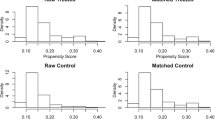Abstract
The study was aimed to evaluate a prospective randomized controlled trial (RCT) In laparoscopic transabdominal preperitoneal inguinal hernia repair (TAPP), whether fixation of the residual sac after transecting the hernia sac can reduce the severity of postoperative seroma. A total of 252 male patients with a primary unilateral indirect inguinal hernia who underwent TAPP from September 2018 to November 2022 were recruited. Patients were randomized to the control group (CG)and the experimental group (EG). In the experimental group, after the hernia sac was transected, the residual sac was fixed to the lower edge of the rectus abdominis, while it was left in the preperitoneal space in the control group. Close follow-up was arranged to observe the incidence of seroma and other postoperative complications. All 214 patients were discharged successfully. 106 patients were randomly assigned to the control group, and 108 patients were assigned to the experimental group. There was no significant difference in the incidence of postoperative fluid extraction between the experimental group and the control group (11.1% VS.10.4%, p = 0.862), but the patients with seroma after the operation had fewer repeated extraction (0% VS. 45.5%, P = 0.033). The incidences of other postoperative complications were comparable in the two groups. In the treatment of indirect inguinal hernia with TAPP, after transecting the hernia sac, suturing and fixing the residual sac to the inferior edge of the rectus abdominis can reduce the incidence of repeated aspiration.


Similar content being viewed by others
References
Massey LH et al (2018) The use of adjuncts to reduce seroma in open incisional hernia repair: a systematic review. Hernia 22(2):273–283
Fang H et al (2021) Drainage decreases the seroma incidence in laparoscopic transabdominal preperitoneal (TAPP) hernia repair for large inguinoscrotal hernias. Asian J Surg 44(3):544–548
Ruze R et al (2019) Correlation between laparoscopic transection of an indirect inguinal hernial sac and postoperative seroma formation: a prospective randomized controlled study. Surg Endosc 33(4):1147–1154
Prassas D, Schumacher FJ (2018) Electric cauterization of the hernia sac in laparoscopic ventral hernia repair reduces the incidence of postoperative seroma: a propensity score-matched analysis. Hernia 22(5):747–750
Li J, Gong W, Liu Q (2019) Intraoperative adjunctive techniques to reduce seroma formation in laparoscopic inguinal hernioplasty: a systematic review. Hernia 23(4):723–731
Fukushima K et al (2019) Impact of age on groin hernia profiles observed during laparoscopic transabdominal preperitoneal hernia repair. Surg Endosc 33(8):2602–2611
Bullen NL et al (2019) Open versus laparoscopic mesh repair of primary unilateral uncomplicated inguinal hernia: a systematic review with meta-analysis and trial sequential analysis. Hernia 23(3):461–472
HerniaSurge G (2018) International guidelines for groin hernia management. Hernia 22(1):1–165
Kockerling F et al (2018) Seroma following transabdominal preperitoneal patch plasty (TAPP): incidence, risk factors, and preventive measures. Surg Endosc 32(5):2222–2231
Schmidt L et al (2019) Surgical techniques and convalescence recommendations vary greatly in laparoscopic groin hernia repair: a nationwide survey among experienced hernia surgeons. Surg Endosc 33(7):2235–2241
Gilbert AI (1989) An anatomic and functional classification for the diagnosis and treatment of inguinal hernia. Am J Surg 157(3):331–333
Vad MV et al (2019) Persistent postoperative pain after inguinal hernia repair in relation to occupational lifting and standing/walking: a 6-month follow-up study. Occup Environ Med 76(10):712–717
Muysoms F et al (2012) EuraHS: the development of an international online platform for registration and outcome measurement of ventral abdominal wall hernia repair. Hernia 16(3):239–250
Gao D et al (2015) Clinical research of preperitoneal drainage after endoscopic totally extraperitoneal inguinal hernia repair. Hernia 19(5):789–794
Susmallian S et al (2001) Seroma after laparoscopic repair of hernia with PTFE patch: is it really a complication? Hernia 5(3):139–141
Morales-Conde S (2012) A new classification for seroma after laparoscopic ventral hernia repair. Hernia 16(3):261–267
Cihan A et al (2006) Fade or fate. Seroma in laparoscopic inguinal hernia repair. Surg Endosc 20(2):325–328
Lund S, Farley D (2019) A decade of experience with laparoscopic ventral hernia repairs. Am J Surg 217(3):546–549
Liu JW et al (2020) Does the use of monopolar energy as the preferred mode of dissection effectively reduce seroma formation in laparoscopic total extra peritoneal hernioplasty? A prospective double-blinded randomized control trial. Hernia 24(4):821–829
Surgit O et al (2016) Use of fibrin glue in preventing pseudorecurrence after laparoscopic total extraperitoneal repair of large indirect inguinal hernia. Ann Surg Treat Res 91(3):127–132
Reddy VM et al (2007) Laparoscopic repair of direct inguinal hernia: a new technique that reduces the development of postoperative seroma. Hernia 11(5):393–396
Daes J (2014) Endoscopic repair of large inguinoscrotal hernias: management of the distal sac to avoid seroma formation. Hernia 18(1):119–122
Author information
Authors and Affiliations
Corresponding author
Ethics declarations
Conflict of interest
All authors declare that there is no conflict of interest.
Funding
This study was funded by the Medical Center of Minimally Invasive Technology of Fujian Province (No. 171, 2017 and No. 4, 2017) and the National Key Clinical Specialty Discipline Construction Program of China. Clinical Trail Registration No.: ChiCTR2100051134.
Ethical approval
The study was approved by the ethical committee of Fujian Medical University Union Hospital.
Informed consent
All participating patients signed informed consent.
Additional information
Publisher's Note
Springer Nature remains neutral with regard to jurisdictional claims in published maps and institutional affiliations.
Rights and permissions
Springer Nature or its licensor (e.g. a society or other partner) holds exclusive rights to this article under a publishing agreement with the author(s) or other rightsholder(s); author self-archiving of the accepted manuscript version of this article is solely governed by the terms of such publishing agreement and applicable law.
About this article
Cite this article
Shi, H., Lin, R., Teng, T. et al. Effects of intraoperative fixation of residual hernia sac on postoperative seroma in laparoscopic transabdominal preperitoneal inguinal hernia repair: a prospective randomized controlled trial. Updates Surg 75, 1343–1349 (2023). https://doi.org/10.1007/s13304-022-01442-y
Received:
Accepted:
Published:
Issue Date:
DOI: https://doi.org/10.1007/s13304-022-01442-y




